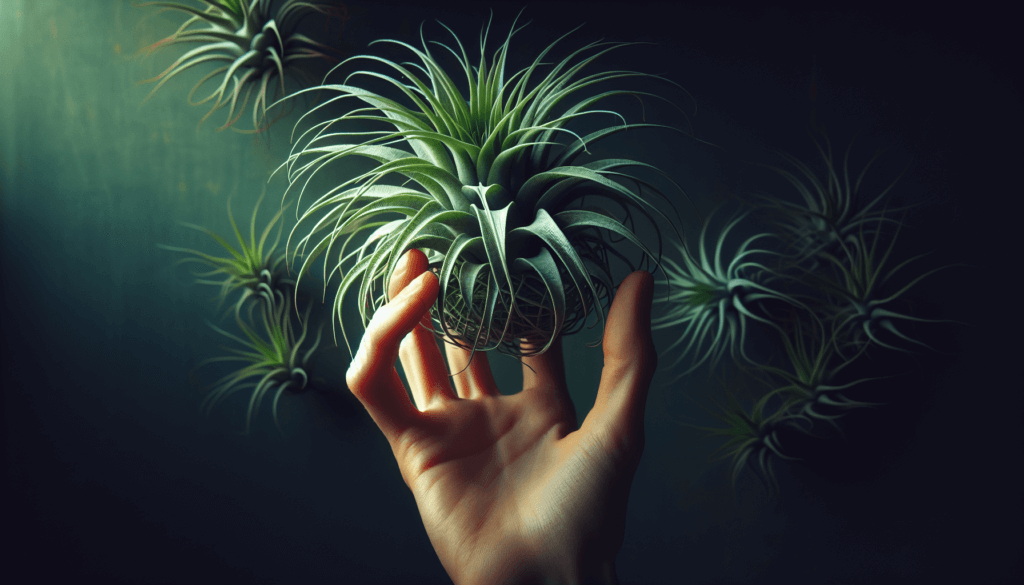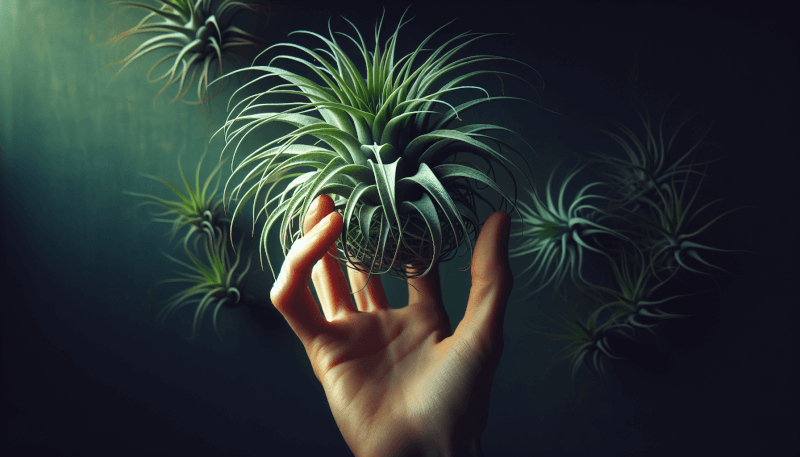If you’re looking for a low-maintenance yet stunning plant to add some greenery to your space, look no further than the Xerographica Air Plant. With its unique silvery foliage and graceful, curly leaves, this air plant is sure to catch anyone’s eye. But how do you take care of this beauty? Fear not, as we’ve got you covered with some simple and friendly tips on Xerographica Air Plant Care. From watering to lighting, we’ll guide you on how to keep this captivating plant thriving and looking its best. So let’s embark on this green journey together, shall we?
Light and Temperature Requirements
Indirect sunlight
When it comes to providing the right amount of light for your Xerographica air plant, indirect sunlight is key. Place your plant in a location where it can receive bright, indirect light throughout the day. This could be near a north-facing window or in a room that receives plenty of ambient light. Avoid placing it in direct sunlight, as this can lead to sunburn and damage the leaves.
Ideal temperature range
Xerographica air plants thrive in temperatures between 60°F and 80°F (15°C to 26°C). They are adaptable to a wide range of temperatures, but it’s best to avoid extremes. Keep your plant away from drafts or areas with fluctuating temperatures, such as near heating vents or air conditioning units.
Watering
Mist the leaves
Xerographica air plants absorb water through their leaves, so misting them regularly is recommended. Fill a spray bottle with clean, lukewarm water and mist the leaves of your plant every few days. This will provide the required hydration and simulate the environment of their natural habitat.
Soak the plant
In addition to misting, it’s important to give your Xerographica air plant a good soak every few weeks. Submerge the plant in a bowl or sink filled with room temperature water for about 20-30 minutes. Be sure to fully submerge the plant, allowing water to reach the base of the leaves. This thorough soaking will ensure that your air plant gets the hydration it needs.
Allow it to dry completely before watering again
After each watering, it’s crucial to let your Xerographica air plant dry completely before watering it again. This is because excessive moisture can lead to root rot and other problems. After soaking or misting, place the plant in a well-ventilated area where it can dry out within 4-6 hours. Avoid keeping it in a closed container or an area with poor air circulation.
Humidity
Provide moderate humidity
While Xerographica air plants are adaptable to varying humidity levels, it’s best to provide them with moderate humidity. Aim for a humidity level between 40% and 60%. If your environment is too dry, you can increase humidity by placing a tray with water near the plant or using a humidifier in the room.
Avoid overly dry or humid environments
On the flip side, Xerographica air plants can also suffer in overly dry or humid environments. Avoid placing your plant near sources of dry air, such as heaters or air conditioners, as this can cause the leaves to dry out. Similarly, excessive humidity can create a breeding ground for mold and rot. Strive for a balance that mimics their natural habitat.

Air Circulation
Provide good air circulation
Like all air plants, Xerographica air plants thrive with good air circulation. It’s important to ensure that there is enough airflow around your plant to prevent the buildup of excessive moisture. Place your air plant in an area with moderate air movement, such as near a fan or an open window. This will help prevent stagnant air and promote healthy growth.
Avoid excessively still or stagnant air
On the other hand, excessively still or stagnant air can be detrimental to your Xerographica air plant. Avoid placing it in enclosed spaces or areas with poor ventilation, as this can lead to fungal growth and other issues. If you notice that the air in your plant’s location feels stagnant, consider adding a small fan or periodically moving the plant to a different spot.
Fertilization
Use a balanced fertilizer
To keep your Xerographica air plant healthy and thriving, fertilization is key. Choose a balanced air plant fertilizer with a 10-10-10 or similar NPK ratio. This will provide the necessary nutrients to support growth and overall plant health. Avoid using fertilizers designed for other types of plants, as they may not contain the specific nutrients that air plants require.
Apply fertilizer sparingly
When it comes to fertilizing your Xerographica air plant, less is more. Apply fertilizer sparingly, using only a quarter or half of the recommended dosage. Air plants are sensitive to excess nutrients, so it’s important not to over-fertilize. A gentle approach with fertilization is typically sufficient to support healthy growth.
Follow recommended dosage and frequency
Be sure to follow the recommended dosage and frequency indicated on the fertilizer packaging. Typically, air plants require fertilization every 2-4 weeks during their active growing season, which is usually spring and summer. During the rest periods, it’s best to reduce or eliminate fertilization to allow the plant to rest and recover.
Pruning
Trim dead or damaged leaves
Regular pruning plays a vital role in maintaining the vitality and appearance of your Xerographica air plant. As you inspect your plant, be on the lookout for any dead or damaged leaves. These can be trimmed off using clean, sterilized pruning shears or scissors. Removing these leaves will not only improve the overall aesthetic of your plant but also promote healthy new growth.
Remove any offsets or pups
Xerographica air plants are known for producing offsets or pups, which are small plants that grow alongside the main plant. As these offsets mature, they can either remain attached or be cut off and propagated into new plants. If you prefer to keep your Xerographica as a single plant, it’s recommended to remove the offsets once they reach approximately one-third the size of the parent plant. This will allow the parent plant to focus its energy on growth and vitality.
Pest Control
Check for pests regularly
Pests can sometimes find their way onto your Xerographica air plant, so it’s important to check for any signs of infestation regularly. Inspect both the leaves and the base of the plant for any tiny pests such as aphids, mealybugs, or spider mites. Catching an infestation early makes it easier to control and prevent further damage.
Remove pests manually
If you spot any pests on your Xerographica air plant, it’s best to remove them manually. Gently wipe the affected areas with a cotton swab dipped in rubbing alcohol, or use a soft brush to dislodge them. Be sure to repeat this process until all pests have been eliminated. Regularly monitoring and manually removing pests will help keep your air plant healthy and pest-free.
Use natural insecticides if necessary
If the infestation persists or becomes severe, you may need to resort to natural insecticides. Look for insecticides specifically designed for use on air plants, as other types of insecticides may be too harsh and can damage the plant. Follow the instructions on the product carefully and apply the natural insecticide as necessary, taking care to protect yourself and the environment.
Mounting or Displaying
Choose a suitable mount
When it comes to displaying your Xerographica air plant, there are various options to choose from. You can mount your air plant on a piece of driftwood, attach it to a wire frame, or place it in a decorative container. Whichever option you choose, ensure that it provides stability and allows for proper air circulation around the plant.
Attach the air plant securely
To ensure that your Xerographica air plant stays in place, it’s important to attach it securely to the chosen mount. Use non-toxic plant glue, fishing line, or floral wire to secure the base of the plant to the mount. Take care not to damage the plant during this process and make any adjustments as necessary to achieve the desired display.
Add decorative elements if desired
To enhance the aesthetic appeal of your Xerographica air plant, you can incorporate decorative elements into its display. This could include adding colorful rocks, shells, or moss around the base of the plant or placing it in a decorative holder. Get creative and experiment with different elements to create a visually pleasing arrangement that suits your style.
Resting Periods
Allow the plant to rest
Xerographica air plants, like many other air plants, go through resting periods where they require less water and fertilizer. These rest periods typically occur in late fall and winter when the days are shorter and the light intensity decreases. During this time, it’s crucial to allow your air plant to rest and conserve its energy for future growth.
Reduce watering and fertilizer during rest periods
To support the natural resting cycle of your Xerographica air plant, reduce the frequency of watering and fertilizer during this time. Instead of misting every few days, mist the plant only once a week or even less frequently. Similarly, decrease the amount and frequency of fertilization to provide the plant with a well-deserved rest. Resuming regular care once the resting period is over will help ensure the plant’s continued health and vitality.
Propagation
Separate offsets from the main plant
Propagation is a great way to expand your collection of Xerographica air plants. To propagate your plant, start by identifying offsets or pups that have grown alongside the main plant. Once the offsets have reached approximately one-third the size of the parent plant, gently detach them from the main plant using clean, sterilized pruning shears or scissors.
Plant the offsets in a suitable medium
After separating the offsets, it’s time to plant them in a suitable medium. Choose a well-draining medium such as air plant-specific soil mix or a blend of orchid bark and sphagnum moss. Plant the offsets, making sure to bury their bases in the medium while leaving the leaves exposed. This will provide them with the necessary stability and access to nutrients.
Provide adequate care for new plants
Once the offsets are planted, it’s important to provide them with adequate care to support their growth. Place them in a location with bright, indirect light and moderate humidity. Follow the watering and fertilization guidelines mentioned earlier, adjusting them slightly to account for the smaller size of the new plants. With proper care, the offsets will grow into mature Xerographica air plants, perpetuating the cycle of life.


